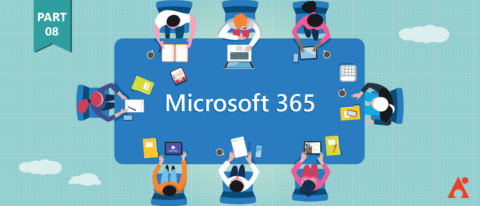Inside Tips for Boosting Your Organization’s Microsoft Teams Adoption (My Teams #8)


New to Microsoft Teams and want to learn the best tips from industry experts? Check out our free webinar on-demand “Beginner to Super User: Top 10 Microsoft Teams Tips!”
The “My Teams” series is broken into the following categories. Click on one to see the full list of articles in that category:
- The AvePoint Microsoft Teams Story
- Microsoft Teams Case Studies
- Microsoft Teams Features and Functions
–Top Microsoft Teams Tips STRAIGHT From AvePoint’s Solution Engineers
–Why Consolidating My Work in Microsoft Teams Was a Game Changer
–How to Create Bots and Optimize Your Microsoft Teams Environment
–Why Integrating Bots into Microsoft Teams is a Smart Move
Rima Reyes is the Senior Program Director at Microsoft for the Teams Engineering Product Group. She currently works to help government agencies of all levels fully leverage Microsoft Teams (quite fitting for this series!). In part eight of this series, we’ll be going over best practices for adopting Microsoft Teams and getting started with the platform.

Name: Rima Reyes
Location: Washington, DC
Current Role: Senior Program Manager, Microsoft Teams Engineering
One word that best describes how you work: Authentically
Mobile device of choice: iPhone XS Max
Computer of choice: Surface Book 2
To get started, please tell us a little about your background and how you got to where you are today.
My professional career started after I graduated with an Organizational Psychology degree from Penn State in 2005. I was thrown into SharePoint after my first year of college while working at Northrop Grumman supporting the US Federal Government. (Side note: I’ve always loved technology, so after work I would go home and read SharePoint books at night.) My hard work paid off because, in 2009, I began working at the White House where I helped maintain and operate multiple SharePoint environments for the President and his staff (which was the coolest job!).
My dream to work for Microsoft came true in 2015. After 3 years in Microsoft Consulting Services, I decided to switch roles and start focusing on a different product: Microsoft Teams. (I still love SharePoint, but Microsoft Teams started giving me that same excitement that SharePoint used to when I first started my career.) So, I switched roles and became a Senior Program Manager for Microsoft Teams Engineering, focusing on our strategic customers and Teams adoption.
How do you juggle Microsoft Teams in an ecosystem that heavily uses Yammer, SharePoint team sites, and email?
When I first joined the Microsoft Product Group something was glaringly evident to me. Email was used for external communication, meaning communicating with anyone outside of Microsoft. Microsoft Teams was then primarily used for internal communication and had replaced the use of email almost completely. I also found that I was being added to Teams conversations only if my input was really needed (versus simply CC’ing me on every single email on the planet with Outlook).
Because SharePoint is so versatile within Microsoft Teams, there’s no one way that my teammates use it. Those of my teammates who are well-versed in SharePoint tend to use it to publish content in a way that’s aesthetically pleasing and then pin it as a tab within a Team. Those who aren’t as magnetized towards SharePoint use it for its integrated file storage capabilities. With it, they can sync the Team site’s Shared Documents library with their OneDrive Sync Client for easy access to content from File Explorer.
Yammer is an interesting one. Those of my teammates who do a lot of community outreach use Yammer just for that. It’s a great way for employees to voice their questions and get some heavy hitters within the company to answer.

What are the biggest roadblocks for organizations trying to adopt Microsoft Teams today?
The biggest issue I see across all customers implementing Teams is that they don’t have anyone in their organization dedicated to Service Adoption. Service Adoption is the ability for individuals to accept, learn and use new technology. This integral piece of the puzzle is usually forgotten and is one of the main reasons Teams deployments don’t hit the ground running.
The other major issues are compliance and governance. Most organizations spend a substantial amount of time trying to get this right before anyone even touches Microsoft Teams. Then when pilot users start using Teams, compliance and governance tweeks need to be made anyway. My recommendation is to get 5-10 trusted individuals in the org to start using Teams, and then make the big compliance/governance decisions. Only then do most organizations get it right.
How do you recommend getting started with Microsoft Teams?
Pilots are a great way to start using Microsoft Teams. Most people start pilots with the folks in IT, and then move to include various users from all over the world to test connectivity and such. I’m not necessarily saying that’s wrong, but the best way to start a pilot is with a trusted group of individuals who actually work together to achieve a common goal. If you include “randoms” from the organization they’ll have little reason to leverage Microsoft Teams.
Need advice on how to achieve Microsoft Teams adoption at your organization? Check out this article: Click To Tweet
What are the top success criteria for executing a Microsoft Teams pilot?
Pilots are best when executed in waves. Wave 1 includes that trusted group of individuals that I mentioned above. Wave 2 includes other groups of people that work within multiple Teams. Wave 3 includes anomalies like folks who travel a lot, are more mobile reliant, etc. And finally, wave 4 should include some of your key stakeholders in the org that will help evangelize the product for you. For each of these waves, make sure you have a kickoff with live training. Target those team leaders that will encourage their team members to use Microsoft Teams to get their projects done. Make all of these people feel special too. After all, they’re trailblazers!
What is the biggest impact you think Microsoft Teams can have on an organization?
The biggest problem I am seeing Teams solving is the issue of content relevance. The ability to pin the most important pieces of information into Microsoft Teams is equivalent to having curated content specific to that work team. This means spending less time on what people think they should know and more time focusing on what their team lead is telling them.
The speed in how we communicate is changing with Microsoft Teams too. Think about the last time you sent an email because you needed a simple question answered by several people you work with. 3 hours and 20 “broken chain” email replies later, and your question still isn’t answered. However, if you move the same scenario to Microsoft Teams, you can “@ mention” individuals to target the right people (and have them receive the right notifications too!). All replies are within context and are persistent so there’s no more “breaking the chain” like with email. People also tend to respond quicker in chat because it’s less formal, needing less time to prepare a response. Those 3 hours just turned into 15 minutes.

Is Microsoft Teams another collaboration application or a platform? What’s the distinction?
I like to call Microsoft Teams a platform. Why? Because you can customize it! You can develop custom apps, create bots, and integrate a plethora of 3rd party applications. It is a collaboration application in its purest form, but in my mind it’s so much more….
In our next installment, Microsoft’s Jace Moreno will talk about the different uses for bots in Microsoft Teams.


